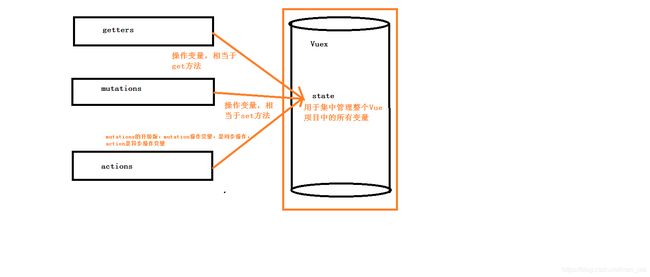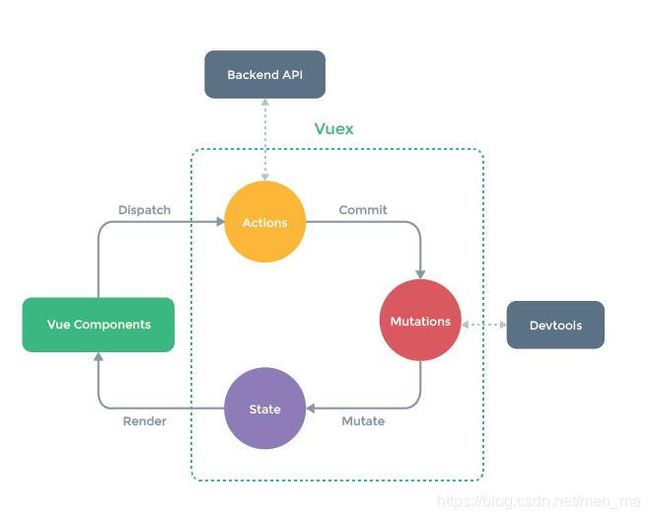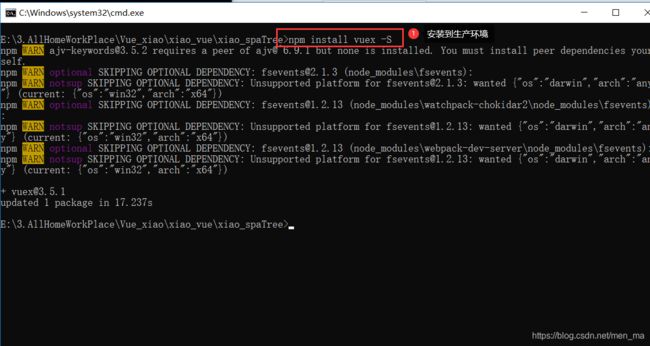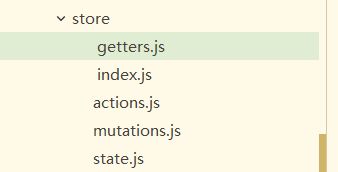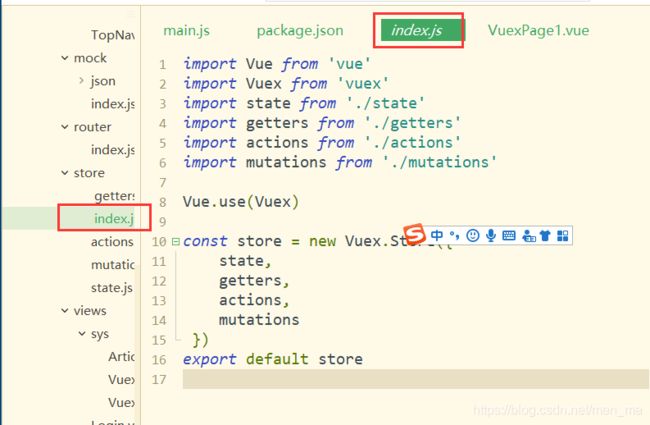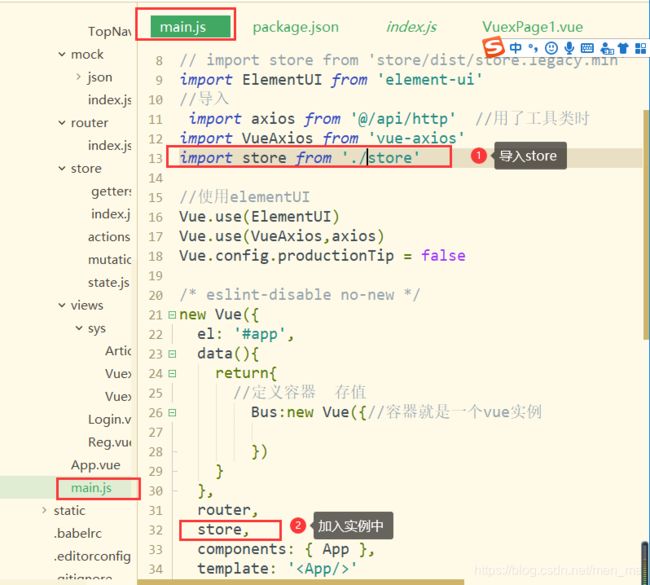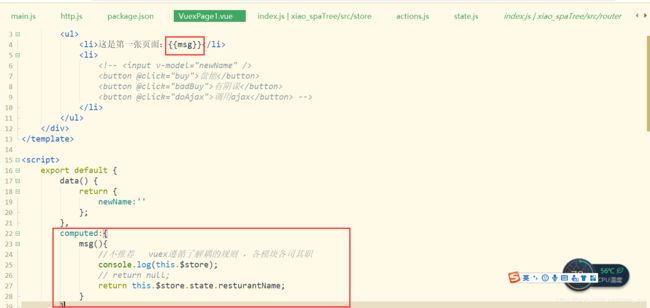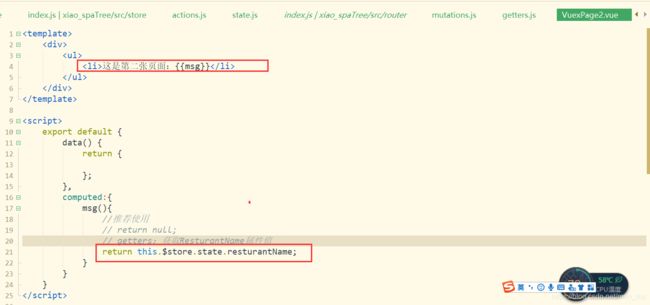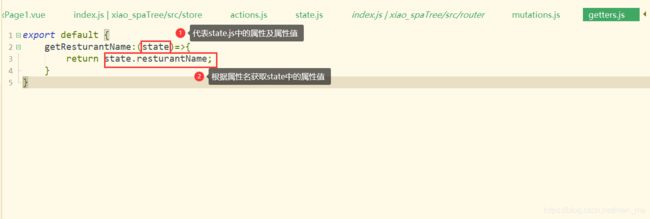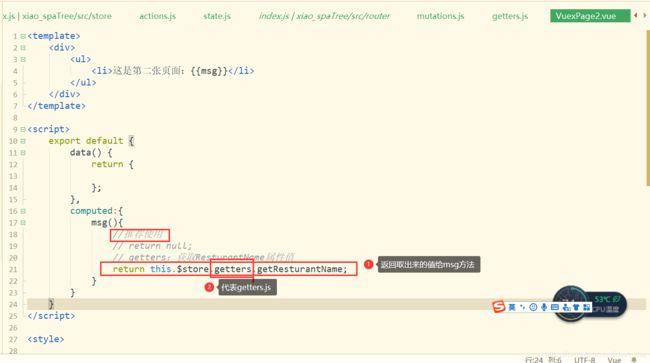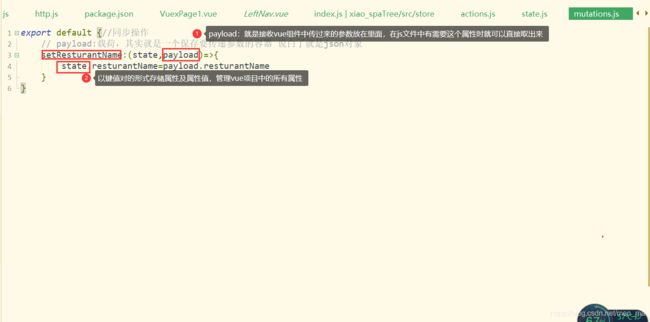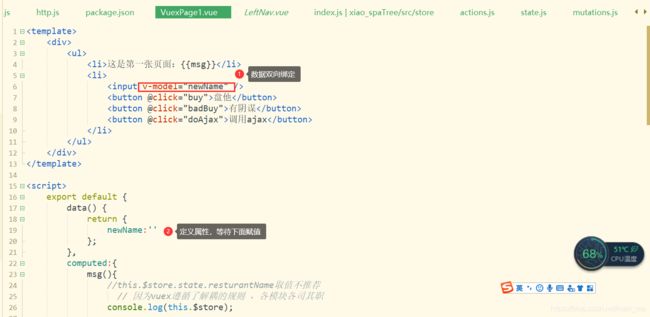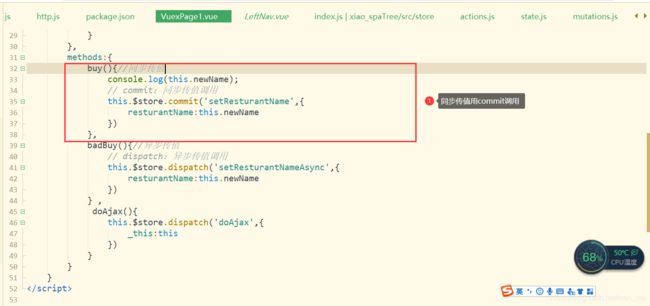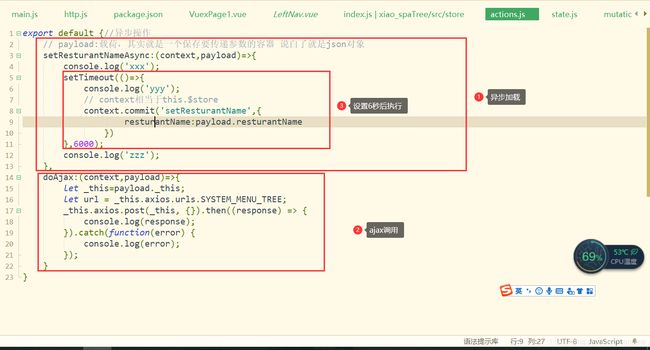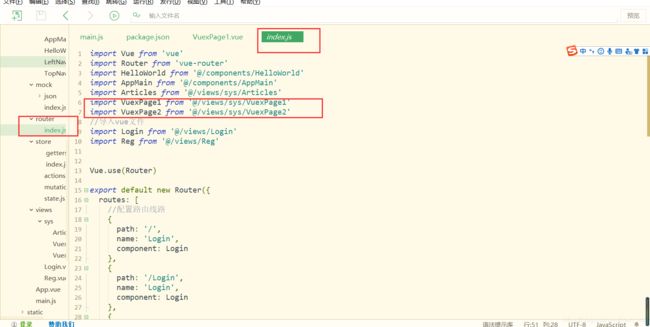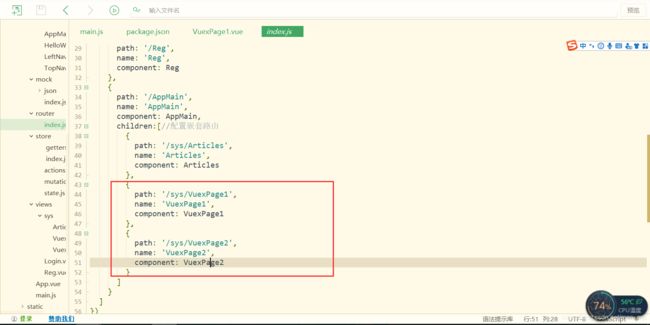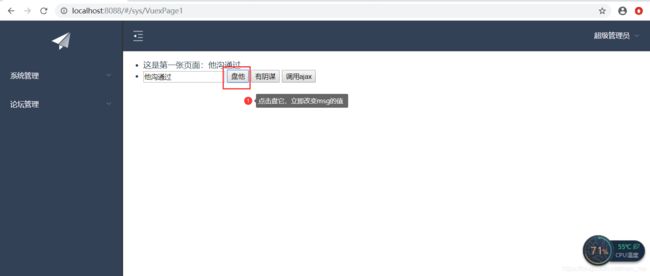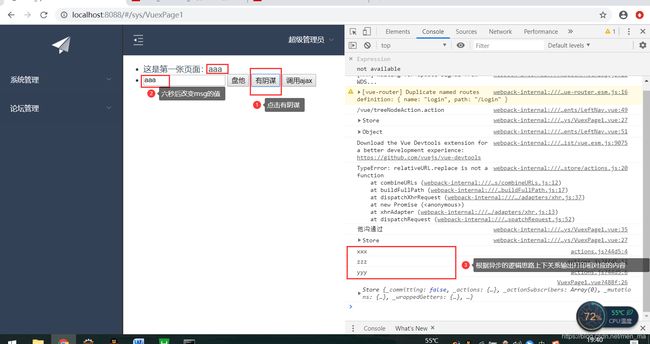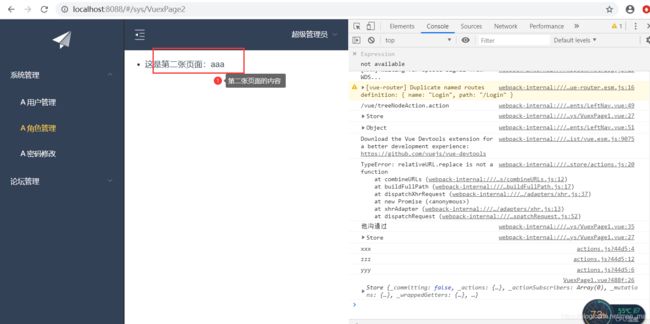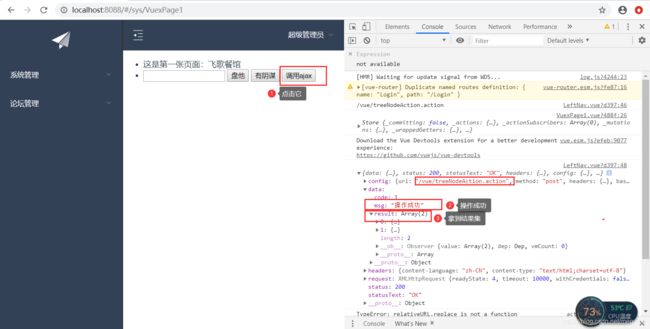vuex+elementUI&如何使用vuex?&如何安装vuex?
转载请标明出处:https://blog.csdn.net/men_ma/article/details/106847165.
本文出自 不怕报错 就怕不报错的小猿猿 的博客
如何使用vuex?&如何安装vuex?
- 前言
- 本次目标
- 学习vuex的目的是为什么
- 1.vue中各个组件之间传值
- 2.vuex中的各个js文件的用途
- 3.vuex使用步骤
-
- 3.1 安装
- 3.2 创建store模块,分别维护state/actions/mutations/getters
- 3.3 在store/index.js文件中新建vuex的store实例,并注册上面引入的各大模块
- 3.4 在main.js中导入并使用store实例
- 3.5 之后按要求编码,即可使用vuex的相关功能
- 3.6 vuex的核心概念:store、state、getters、mutations、actions
- 4.Vuex取值
-
- 4.1 第一张取值方式:this.$store.state.resturantName(不推荐)
- 4.2 第二种取值方式:利用getters箭头函数获取值(推荐使用)
- 5 Vuex存值
-
- 5.1 mutations同步传值(也就是set值)
- 6.Vuex异步加载(action.js)
-
- 6.1 action.js:异步加载
- 总代码
- 效果
- 总结
前言
本次目标
1、了解vuex中的各个js文件的用途
2、利用vuex存值
3、利用vuex取值
4、Vuex的异步加载问题
学习vuex的目的是为什么
vuex是为了解决传值的问题,前面的博客中讲了两种传值的方式,父传子和子传父,这两种的的传值方式都很麻烦,随后就出现了总线传值,也有缺陷,所以现在我们用vuex来解决传值的问题(子孙很多代)

1.vue中各个组件之间传值
1. vue中各个组件之间传值
1.父子组件
父组件-->子组件,通过子组件的自定义属性:props
子组件-->父组件,通过自定义事件:this.$emit('事件名',参数1,参数2,...);
2.非父子组件或父子组件
通过数据总数Bus,this.$root.$emit('事件名',参数1,参数2,...)
3.非父子组件或父子组件
更好的方式是在vue中使用vuex
方法1: 用组件之间通讯。这样写很麻烦,并且写着写着,估计自己都不知道这是啥了,很容易写晕。
方法2: 我们定义全局变量。模块a的数据赋值给全局变量x。然后模块b获取x。这样我们就很容易获取到数据
2.vuex中的各个js文件的用途
vuex是专为vue.js应用程序开发的状态管理模式。
vuex用于集中管理整个vue项目中的所有变量,就好比一个数据库
如下图(图解Vuex各组件):
注1:
状态管理有5个核心,分别是state、getter、mutation、action以及module。分别简单的介绍一下它们:
1、state:单一状态树
state为单一状态树,在state中需要定义我们所需要管理的数组、对象、字符串等等,只有在这里定义了,在vue.js的组件中才能获取你定义的这个对象的状态。
2、getter:状态获取
getter有点类似vue.js的计算属性,当我们需要从store的state中派生出一些状态,那么我们就需要使用getter,getter会接收state作为第一个参数,而且getter的返回值会根据它的依赖被缓存起来,只有getter中的依赖值(state中的某个需要派生状态的值)发生改变的时候才会被重新计算。
3、mutation:触发同步事件
更改store中state状态的唯一方法就是提交mutation,就很类似事件。每个mutation都有一个字符串类型的事件类型和一个回调函数,我们需要改变state的值就要在回调函数中改变。我们要执行这个回调函数,那么我们需要执行一个相应的调用方法:store.commit。
4、action:提交mutation,可以包含异步操作
action可以提交mutation,在action中可以执行store.commit,而且action中可以有任何的异步操作。在页面中如果我们要嗲用这个action,则需要执行store.dispatch
5、module:将vuex进行分模块
module其实只是解决了当state中很复杂臃肿的时候,module可以将store分割成模块,每个模块中拥有自己的state、mutation、action和getter。
3.vuex使用步骤
3.1 安装
npm install vuex -S
3.2 创建store模块,分别维护state/actions/mutations/getters
各模块的作用前面已介绍
store
index.js 默认模块
state.js
actions.js
mutations.js
getters.js
3.3 在store/index.js文件中新建vuex的store实例,并注册上面引入的各大模块
import Vue from 'vue'
import Vuex from 'vuex'
import state from './state'
import getters from './getters'
import actions from './actions'
import mutations from './mutations'
Vue.use(Vuex)
const store = new Vuex.Store({
state,
getters,
actions,
mutations
})
export default store
3.4 在main.js中导入并使用store实例
import store from './store'
new Vue({
el: '#app',
router,
store, //在main.js中导入store实例
components: {
App
},
template: '3.5 之后按要求编码,即可使用vuex的相关功能
3.6 vuex的核心概念:store、state、getters、mutations、actions
4.0 store
每一个Vuex应用的核心就是store(仓库),store基本上就是一个容器,它包含着你的应用中大部分的状态 (state)。
const store = new Vuex.Store({
state, // 共同维护的一个状态,state里面可以是很多个全局状态
getters, // 获取数据并渲染
actions, // 数据的异步操作
mutations // 处理数据的唯一途径,state的改变或赋值只能在这里
})
4.Vuex取值
4.1 第一张取值方式:this.$store.state.resturantName(不推荐)
1 state(保存数据的容器)
状态,即要全局读写的数据
const state = {
resturantName:'飞歌餐馆'
};
this.$store.state.resturantName;//不建议
2 getters(getXxx)
获取数据并渲染,
const getters = {
resturantName: (state) => {
return state.resturantName;
}
};
注1:getters将state中定义的值暴露在this.$store.getters对象中,我们可以通过如下代码访问
this.$store.getters.resturantName
注2:state状态存储是响应式的,从store实例中读取状态最简单的方法就是在计算属性中返回某个状态,如下:
computed: {
resturantName: function() {
return this.$store.getters.resturantName;
}
}
第一张页面取值的效果(说明vuex能够正常使用):
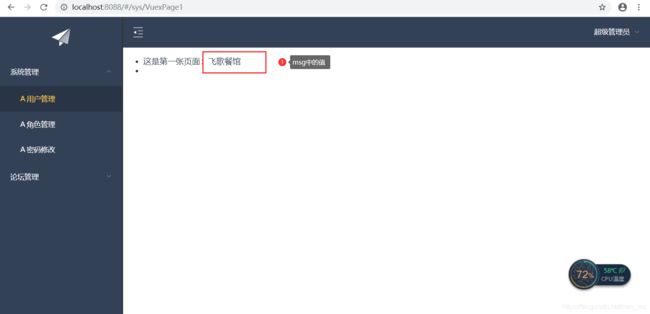
第二张页面取值的效果(说明vuex能够正常使用):

4.2 第二种取值方式:利用getters箭头函数获取值(推荐使用)
5 Vuex存值
处理数据的唯一途径,state的改变或赋值只能在这里
export default {
// type(事件类型): 其值为setResturantName
// payload:官方给它还取了一个高大上的名字:载荷,其实就是一个保存要传递参数的容器
setResturantName: (state, payload) => {
state.resturantName = payload.resturantName;
}
}
注1:mutations中方法的调用方式
不能直接调用this.$store.mutations.setResturantName('KFC'),必须使用如下方式调用:
this.$store.commit(type,payload);
// 1、把载荷和type分开提交
store.commit('setResturantName',{
resturantName:'KFC'
})
// 2、载荷和type写到一起
store.commit({
type: 'setResturantName',
resturantName: 'KFC'
})
注2:一定要记住,Mutation 必须是同步函数。为什么呢?异步方法,我们不知道什么时候状态会发生改变,所以也就无法追踪了
如果我们需要异步操作,Mutations就不能满足我们需求了,这时候我们就需要Actions了
mutations: {
someMutation (state) {
api.callAsyncMethod(() => {
state.count++
})
}
}
5.1 mutations同步传值(也就是set值)
mutations.js
export default {//同步操作
// payload:载荷,其实就是一个保存要传递参数的容器 说白了就是json对象
setResturantName:(state,payload)=>{
state.resturantName=payload.resturantName
}
}
6.Vuex异步加载(action.js)
export default {
setResturantNameByAsync: (context, payload) => {
console.log('xxxx');
setTimeout(() => {
console.log('yyyy');
console.log(payload)
// state.resturantName = payload.resturantName;
context.commit('setResturantName', payload); //Action提交的是mutation
}, 3000)
console.log('zzzz');
},
doAjax: (context, payload) => {
let _this = payload._this
let url = _this.axios.urls.SYSTEM_USER_DOLOGIN;
_this.axios.post(url, {}).then((response)=> {
console.log(response);
}).catch(function(error) {
console.log(error);
});
}
}
Action类似于 mutation,不同在于:
1.Action提交的是mutation,而不是直接变更状态
2.Action可以包含任意异步操作
3.Action的回调函数接收一个 context 上下文参数,注意,这个参数可不一般,它与 store 实例有着相同的方法和属性
但是他们并不是同一个实例,context 包含:
1. state、2. rootState、3. getters、4. mutations、5. actions 五个属性
所以在这里可以使用 context.commit 来提交一个 mutation,或者通过 context.state 和 context.getters 来获取 state 和 getters。
注1:actions中方法的调用方式语法如下:
this. s t o r e . d i s p a t c h ( t y p e , p a y l o a d ) ; 例 如 : t h i s . store.dispatch(type,payload); 例如:this. store.dispatch(type,payload);例如:this.store.dispatch(‘setResturantNameByAsync’,{resturantName: ‘啃德鸡2’});
注2:action中提交mutation
context.commit(‘setResturantName’,{resturantName: ‘啃德鸡2’});
注3:VUEX 的 actions 中无法获取到 this 对象
如果要在actions 或者 mutations 中使用this对象。可以在调用的时候把this对象传过去
{resturantName: ‘啃德鸡2’,_this:this}//this就是在调用时的vue实例
Vuex中actions的使用场景
场景1:部门管理中添加或删除了新的部门,员工新增/编辑页面的部门列表需要进行变化
场景2:vuex之使用actions和axios异步初始购物车数据
6.1 action.js:异步加载
总代码
VuexPage1.vue:
<template>
<div>
<ul>
<li>这是第一张页面:{{msg}}</li>
<li>
<input v-model="newName" />
<button @click="buy">盘他</button>
<button @click="badBuy">有阴谋</button>
<button @click="doAjax">调用ajax</button>
</li>
</ul>
</div>
</template>
<script>
export default {
data() {
return {
newName:''
};
},
computed:{
msg(){
//this.$store.state.resturantName取值不推荐
// 因为vuex遵循了解耦的规则 ,各模块各司其职
console.log(this.$store);
return this.$store.state.resturantName;
}
},
methods:{
buy(){//同步传值
console.log(this.newName);
// commit:同步传值调用
this.$store.commit('setResturantName',{
resturantName:this.newName
})
},
badBuy(){//异步传值
// dispatch:异步传值调用
this.$store.dispatch('setResturantNameAsync',{
resturantName:this.newName
})
} ,
doAjax(){
this.$store.dispatch('doAjax',{
_this:this
})
}
}
}
</script>
<style>
</style>
VuexPage2.vue:
<template>
<div>
<ul>
<li>这是第二张页面:{{msg}}</li>
</ul>
</div>
</template>
<script>
export default {
data() {
return {
};
},
computed:{
msg(){
//推荐使用
return this.$store.getters.getResturantName;
}
}
}
</script>
<style>
</style>
配置路由:
import VuexPage1 from '@/views/sys/VuexPage1'
import VuexPage2 from '@/views/sys/VuexPage2'
{
path: '/sys/VuexPage1',
name: 'VuexPage1',
component: VuexPage1
},
{
path: '/sys/VuexPage2',
name: 'VuexPage2',
component: VuexPage2
}
效果
效果2:点击有阴谋
总结
vuex 解决了:spa项目原有的总线传参,变量定义过于分散,不方便项目维护,这一问题
